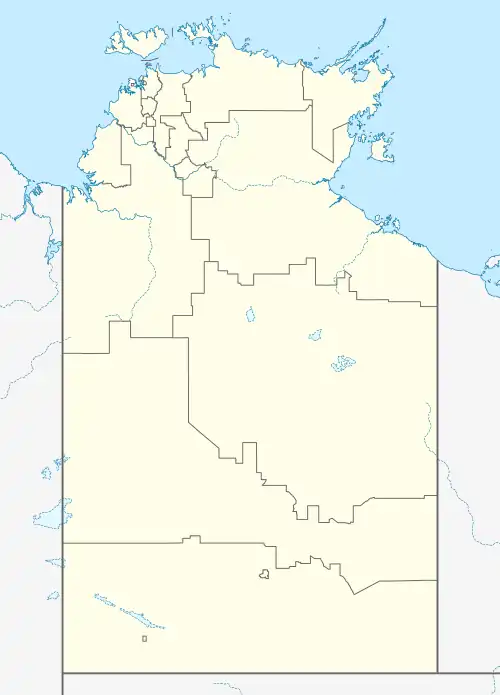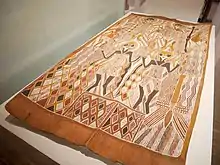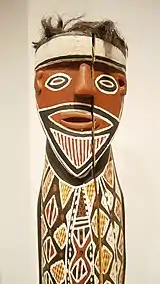Yirrkala
Yirrkala is a small community in East Arnhem Region, Northern Territory, Australia,[1] 18 kilometres (11 mi) southeast of the large mining town of Nhulunbuy, on the Gove Peninsula in Arnhem Land.[2] Its population comprises predominantly Aboriginal Australians[3] of the Yolngu people, and it is also home to a number of Mission Aviation Fellowship pilots and engineers based in Arnhem Land, providing air transport services.
| Yirrkala Northern Territory | |
|---|---|
 Yirrkala | |
| Coordinates | 12°15′10″S 136°53′30″E |
| Population | 809 (2016) |
| Postcode(s) | 0880 |
| Elevation | 8 m (26 ft) |
| Location | |
| LGA(s) | East Arnhem Region |
| Territory electorate(s) | Mulka |
| Federal division(s) | Lingiari |

In the 2016 census, Yirrkala had a population of 809 people.[3]
History
Mission
There has been an Aboriginal community at Yirrkala throughout recorded history, but the community increased enormously in size when Yirrkala mission was founded in 1935, with people from 13 different Yolngu clans moving to Yirrkala.[4] Around this time, the Methodist Overseas Mission (MOM) was encouraging their senior staff to study anthropology under A. P. Elkin at Sydney University, to learn more about Aboriginal Australian culture, in particular the Yolngu people who lived in East Arnhem.[5]
Mission superintendents included founding superintendent Wilbur Chaseling, Harold Thornell, and Edgar Wells, who wrote about their experiences there. The residents were free to come and go as they wished and the interaction was on the whole positive in those early days, with a lack of dogmatism by the missionaries, and the Yolngu people accommodating Christianity within a version of their own beliefs.[5]
MOM received a government subsidy to run the mission, and school classes operated from 1936, at first outdoors under a tree, and later beneath the Mission House. In 1951 a new school building was built, and by 1952, it had 47 children regularly attending classes there, taught by a Miss Proctor. She was not a trained teacher, but had worked at the mission on Goulburn Island for three years. The mission received child endowment for every Aboriginal child there, regardless of attendance at the school.[4]
During World War II, a RAAF airbase operated close by. Many mission residents worked there, as boat pilots for the RAAF and the Royal Australia Navy, or assisted the war effort by other means. The school did not operate during this time, and all "white women" were evacuated in 1942.[4]
Around 1974 control of the mission was passed to the Yirrkala Dhanbul Community Association, and no longer operated as a mission from that time.[4]
Land rights
Yirrkala played a pivotal role in the development of the relationship between Indigenous and non-Indigenous Australians when the document Bark Petition was created at Yirrkala in 1963 and sent to the Federal Government to protest at the Prime Minister's announcement that a parcel of their land was to be sold to a bauxite mining company. Although the petition itself was unsuccessful in the sense that the bauxite mining at Nhulunbuy went ahead as planned, it alerted non-Indigenous Australians to the need for Indigenous representation in such decisions, and prompted a government report recommending payment of compensation, protection of sacred sites, creation of a permanent parliamentary standing committee to scrutinise developments at Yirrkala, and also acknowledged the Indigenous people's moral right to their lands. The Bark Petition is on display in the Parliament House in Canberra.[6]
Outstation status
The settlement was funded as an outstation during the 1980s.[7]
At the 2021 census, Yirrkala had a population of 657.[8]
Governance and people
As of 2023 the East Arnhem Regional Council is the local government for Yirrkala, which is in the council's Gumurr Miwatj Ward. It consults with Yirrkala Mala Leaders Association, consisting of 12 elected community members.[9]
The Northern Land Council is the land council to the community, responsible for matters under the Aboriginal Land Rights (Northern Territory) Act 1976.[9]
In the 2016 census, Yirrkala had a population of 809 people, of whom 83.1% identified as Aboriginal and/or Torres Strait Islander people.[3]
Culture


Yirrkala is home to a number of leading Indigenous artists, whose traditional Aboriginal art, particularly bark painting, can be found in art galleries around the world, and whose work frequently wins awards such as the Telstra National Aboriginal and Torres Strait Islander Art Awards.[10] Their work is available to the public from the Buku-Larrnggay Mulka Art Centre and Museum[11] and also from the YBE art centre. Pioneer bark painters from this region the National Museum of Australia consider old masters include Mithinarri Gurruwiwi, Birrikitji Gumana and Mawalan Marika.[12][13]
It is also a traditional home of the Yidaki (didgeridoo), and some of the world's finest didgeridoos are still made at Yirrkala.
Buku-Larrnggay Mulka Centre
The Buku-Larrnggay Mulka Centre, formerly Buku-Larrŋgay Arts and also known as the Buku-Larrnggay Mulka Art Centre and Museum, is a world-renowned centre, with well-known artists such as Nyapanyapa Yunupingu based there.[14] It is often referred to as Buku for short.[15][16]
The inspiration for the gallery arose in the 1960s, when Narritjin Maymuru set up his own gallery on the beachfront.[17]
In 1976 Buku-Larrŋgay Arts was established by local artists in the old Mission health centre, after missionaries had left and as the Aboriginal land rights and Homeland movements gathered pace. A new museum was built in 1988 using a Bicentenary grant, and this now contains a collection created in the 1970s which illustrates clan law. It also houses the message sticks[17] which, after delivery by the anthropologist Donald Thomson were instrumental in establishing peaceful talks during the Caledon Bay crisis in 1935.[18]
In 1996, extra gallery spaces and a screen print studio were built, and in 2007, The Mulka Project was added. This project comprises a collection of many thousands of historical images and films, and continues to create new digital art and images.[17]
The current centre, greatly expanded, comprises two divisions: the Yirrkala Art Centre, which represents the artists exhibiting and selling contemporary art, and The Mulka Project, which incorporates the museum.[17] It is known for its production of bark paintings, weaving in natural fibres, larrakitj (memorial poles), yidaki, and many other forms of art.[19]
There is a stage called the Roy Marika Stage at the centre, which is used for the annual Yarrapay Festival. In June 2021, the festival was directed by Witiyana Marika, and featured the Andrew Gurruwiwi Band, Yothu Yindi, Yirrmal, and East Journey.[20]
Artists, works and exhibitions
The historic Yirrkala Church Panels were created in 1963 by Yolngu elders of the Dhuwa moiety (including Mawalan Marika, Wandjuk Marika and Mithinarri Gurruwiwi), who painted one sheet with their major ancestral narratives and clan designs, and eight elders of the Yirritja moiety, including Mungurrawuy Yunupingu, Birrikitji Gumana and Narritjin Maymuru, who painted the other sheet with Yirritja designs.[21][22][23] They were discarded by the church in 1974, but were salvaged by Buku-Larrnggay in 1978. On 27 February 1998 they were unveiled by then prime minister John Howard, and were described by Yolŋu leaders as "Title Deeds which establish the legal tenure for each of our traditional clan estates".[21]
The National Gallery of Victoria in Melbourne has been collecting bark paintings by Buku artists for over 20 years, which are included in its significant collection of work by Yolŋu women artists.[24]
Women artists who have worked at the centre include five sisters: Nancy Gaymala Yunupingu, Gulumbu Yunupingu, Barrupu Yunupingu, Nyapanyapa Yunupingu, and Eunice Djerrkngu Yunupingu; as well as Dhuwarrwarr Marika; Malaluba Gumana; Naminapu Maymuru-White; Nonggirrnga Marawili; and Dhambit Mununggurr; and Margaret Wirrpanda. Their work was included in a December 2021 – April 2022 exhibition at the NGV, called Bark Ladies: Eleven Artists from Yirrkala.[15][24][25]
Education
At Yirrkala School, formerly Yirrkala Community School, renamed Yirrkala Community Education Centre or Yirrkala CEC after it became a location of one of the trial Community Education Centres (CEC) in 1988,[26][27] students undertake a method of bilingual studies dubbed "both ways", incorporating a cultural curriculum called Galtha Rom, meaning cultural lessons. Despite a 2009 Northern Territory Government order to teach English for the first four hours each day, the school continued to teach in its own way, with the child's first language, Yolngu Matha, taught alongside English. The method has proven effective against reducing the drop-out rate, and in 2020 eight students were the first in their community to graduate year 12 with scores enabling them to attend university. Yirrkala School and its sister school, Laynhapuy Homelands School, are now being looked to as models for learning in remote traditional communities.[28]
Yalmay Marika Yunupingu
Artist and teacher-linguist Yalmay Marika Yunupingu is one of the famous Marika family of north-east Arnhem Land, daughter of artist Mathaman Marika[29] and sister of artist, cultural leader and environmentalist Dr B Marika. She was married to former Yothu Yindi lead singer and educator Dr M Yunupingu.[30]
Yunupingu was appointed senior teacher at the school in 2004.[28] She was awarded the Northern Territory Government's Teaching Excellence Award in the Remote Primary category for her work at Yirrkala, and her artwork has featured in exhibitions in Australia and the US.[29] She has translated children's books into language, and taught "both ways" bilingual education for her whole career. She retired in early 2023 after 40 years at the school, with family, friends, colleagues and other community members gathering to celebrate her contribution.[30]
Heritage listings

Yirrkala has a number of heritage-listed sites, including:
Notable people
- Timmy Burarrwanga, businessman and cultural leader
- Gatjil Djerrkura (1949–2004), ceremonial leader
- Nathan Djerrkura (1988–), Australian rules footballer
- Nonggirrnga Marawili (c.1938), painter
- Banduk Marika (1954–2021), artist
- Kathy Balngayngu Marika (1957–), dancer
- Raymattja Marika (c.1959–2008), scholar, educator, linguist and cultural advocate
- Roy Marika (1925–1993), councillor and artist
- Wandjuk Marika (1927–1987), artist, actor, Indigenous rights activist
- Yirrmal Marika (1993–), Australian singer
- Maminydjama Maymuru (1997–), model
- Wukun Wanambi
- Kwame Yeboah (born 1994 in Yirrkala), professional football player for the Western Sydney Wanderers
- Yothu Yindi (1986–2000), rock band
- Galarrwuy Yunupingu (1948–2023), land rights activist and chair, Northern Land Council
- Mandawuy Yunupingu (1956–2013), musician and educator
- Nyapanyapa Yunupingu (c.1945), painter
References
- "Yirrkala". NT Place Names Register. Northern Territory Government. Retrieved 14 October 2018.
- "On the Gove Peninsula". Miwatj Health Aboriginal Corporation. Retrieved 5 October 2020.
- Australian Bureau of Statistics (27 June 2017). "Yirrkala (SSC)". 2016 Census QuickStats. Retrieved 13 October 2018.
- George, Gary; George, Karen (8 May 2014). "Yirrkala Mission - Summary". Find & Connect. Retrieved 7 June 2023.
Created: 7 February 2011, Last modified: 8 May 2014
- Morphy, Howard (2005). "Mutual conversion?: The methodist church and the Yolngu, with particular reference to Yirrkala". Humanities Research. ANU Press. IX (1): 41-53. Retrieved 7 June 2023. PDF
- "Yirrkala bark petitions 1963 (Cth)". Documenting A Democracy. Museum of Australian Democracy. Retrieved 16 July 2021.
- Parliament of Australia. House of Representatives Standing Committee on Aboriginal Affairs; Blanchard, Allen (March 1987). Inquiry into the Aboriginal homelands movement in Australia. ISBN 0-644-06201-0. Retrieved 16 August 2020.
{{cite book}}:|website=ignored (help) PDF - Yirrkala (L). 2021 Yirrkala (L), Census All persons QuickStats | Australian Bureau of Statistics. (n.d.). https://www.abs.gov.au/census/find-census-data/quickstats/2021/UCL721016
- "Yirrkala in detail". East Arnhem Regional Council. Retrieved 16 August 2020.
- "Art Right Now2 – IndgRes". gallery.discoverymedia.com.au. Retrieved 16 November 2018.
- "Buku Art Centre". Retrieved 16 November 2018.
- Old masters : Australia's great bark artists. National Museum of Australia. (1st ed.). Canberra, ACT, Australia. 2013. ISBN 9781921953163. OCLC 857187130.
{{cite book}}: CS1 maint: location missing publisher (link) CS1 maint: others (link) - "Mawalan Marika | Yirrkala bark Painting | painting | sell Mawalan Marika painting". Aboriginal Bark Paintings. 18 October 2017. Retrieved 22 August 2019.
- "Coronavirus restrictions are easing, and now this NT gallery is marking two milestones – ABC News". Australian Broadcasting Corporation. 29 May 2020. Retrieved 30 May 2020.
- Perin, Victoria (13 December 2021). "Bark Ladies centres female Yolŋu artists". Art Guide Australia. Retrieved 7 July 2022.
- Kubler, Alison (19 February 2022). "Bark Ladies at NGV review: This exhibition will knock your socks off". Escape. Retrieved 7 July 2022.
- "Buku-Larrŋgay Mulka". Buku-Larrŋgay Mulka Centre. Retrieved 30 May 2020.
- Kelly, Piers (4 July 2019). "Australian message sticks: Old questions, new directions". Journal of Material Culture. SAGE Publications. 25 (2): 133–152. doi:10.1177/1359183519858375. ISSN 1359-1835.
- "Buku-Larrŋgay Mulka Centre". Art Gallery of South Australia. Retrieved 6 July 2022.
- Rirratjingu Aboriginal Corporation. "Annual Report 2021–2021" (PDF). p. 15. Retrieved 17 January 2022.
- Northern Myth (11 July 2013). "Yirrkala Church Panels: how pictures redrew indigenous history". Crikey. Retrieved 5 July 2022.
- "Marking Places, Cross-Hatching Worlds: The Yirrkala Panels". E-flux Journal (111). September 2020. Retrieved 5 July 2022.
- "Buku-Larrnggay Mulka (Yirrkala)". Lauraine Diggins Fine Art. Retrieved 5 July 2022.
- "NGV International presents Bark Ladies: Eleven Artists from Yirrkala". Australian Design Review. 6 December 2021. Retrieved 7 July 2022.
- "Bark Ladies to open at NGV International". green magazine. 18 August 2021. Retrieved 7 July 2022.
- "Yirrkala Community Education Centre". Adelaide Schools. Retrieved 27 July 2021.
- Education in the Yirrkala Area (PDF) (Report). Nambara Schools Council Submission to the HREOC Rural and Remote Education Inquiry. Nambara Schools Council. 1999. Retrieved 27 July 2021.
{{cite report}}: CS1 maint: others (link) - Masters, Emma (11 July 2021). "At Yirrkala School, bilingual education has become a model for remote Aboriginal learning". ABC News. Australian Broadcasting Corporation. Retrieved 16 July 2021.
- "The Marika family". National Museum of Australia. Retrieved 27 July 2021.
- James, Felicity (20 March 2023). "Yolngu elder and bilingual educator Yalmay Yunupingu retires from Yirrkala school". ABC News. Australian Broadcasting Corporation. Retrieved 21 March 2023.
- "Wurrwurrwuy (Place ID 106088)". Australian Heritage Database. Australian Government. Retrieved 13 October 2018.
Further reading
- Fitzgerald, M. (2022). "Mirrored realms: The bark ladies of Yirrkala". Art Monthly Australasia, (331), 86–91.
- Salvestro, Denise Yvonne (April 2016). Printmaking by Yolngu artists of Northeast Arnhem Land: 'Another way of telling our stories' (PhD). Australian National University.